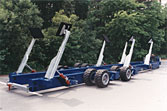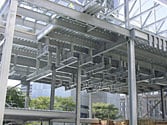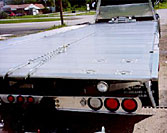69 Norman St.
Everett, MA 02149
Phone: 617-389-8440
Fax: 617-389-2831
69 Norman St.
Everett, MA 02149
Phone: 617-389-8440
Fax: 617-389-2831

When a galvanized assembly incorporates moving parts (such as drop-handles, shackles and shafts), a radial clearance of not less than 1/16 inch (1.59 mm) must be allowed to ensure full freedom of movement after the addition of zinc during galvanizing.
It is recommended that, whenever possible, work be designed so that hinges can be bolted to frames, covers, bodies and the like after galvanizing.
Hinges should be galvanized separately and assembled after galvanizing. All hinges to be galvanized should be of the loose pin type. Before galvanizing, any adjacent edges should be ground to give at least 1/32 inch (0.8 mm) clearance. The pin holes can be cleared of excess zinc at time of assembly. After hinges are galvanized, it is recommended that an undersized pin be used to compensate for the zinc picked up during the galvanizing process. If desired, the pin holes in the hinges may be reamed 1/32 inch (0.8 mm) after galvanizing to permit the use of regular size pins.
At times, it is necessary to reheat moving parts in order to make them work freely. Heating may cause discoloration of the galvanized coating near the reheated area.

Identification markings on fabricated items should be carefully prepared before galvanizing, so they will be legible after galvanizing.
Do not use paint to apply addresses, shipping instructions, and job numbers on items to be galvanized. Oil based paints and crayon marks are not removed by the pickling acids. This results in extra work and extra charges by the galvanizer to properly prepare the steel for galvanizing.
For temporary identification, detachable metal tags or a water soluble marker should be specified.
Where permanent identification is needed, there are three suitable alternatives for marking steel fabrications to be hot dip galvanized. Each will enable items to be rapidly identified after galvanizing and at the assembly site. The three marking alternatives are:
Do not use aluminum, plastic, paper, or paint to mark an item before galvanizing.

Sometimes hot dip galvanized coatings are damaged by excessively rough handling during shipping or erection. Damage may also be the result of welding or flame cutting.
Where limited areas are damaged, the use of low melting point zinc alloy repair rods or powders, the use of organic zinc rich paint or the use of sprayed zinc (metallizing) is recommended to protect the area.
ASTM Recommended Practice A780 “Repair of Damaged Hot Dip Galvanizing Coatings” covers acceptable methods of reconditioning the damaged areas.

For effective galvanizing, cleaning solutions and molten zinc must flow into, over, through and out of the fabricated article without undue resistance.
Failure to provide for this free, unimpeded flow is a frequent cause of problems for both galvanizer and customer. Improper design for drainage results in galvanizing of poor appearance and in excess buildups of zinc which are unnecessary and costly.
To ensure unimpeded flow of solutions, all stiffeners, gussets and bracing should be cropped a minimum of 3/4 inch (19.05 mm).
Provide holes at least 1/2 inch (13 mm) in diameter in end plates on rolled steel shapes, to allow access of molten zinc in the galvanizing bath and drainage during withdrawal. Alternatively, holes at least 1/2 inch (13 mm) in diameter can be located in the web within 1/4 inch (6 mm) of the end plate.
Duncan Galvanizing, Corp. 69 Norman Street, Everett, MA 02149 Phone: 617-389-8440
© 2018 Duncan Galvanizing, Corp. All Rights Reserved Privacy Policy Site Map